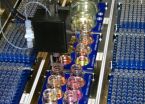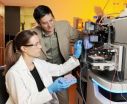(Press-News.org) DURHAM, N.C. -- While physicists at the Large Hadron Collider smash together thousands of protons and other particles to see what matter is made of, they're never going to hurl electrons at each other. No matter how high the energy, the little negative particles won't break apart. But that doesn't mean they are indestructible.
Using several massive supercomputers, a team of physicists has split a simulated electron perfectly in half. The results, which were published in the Jan. 13 issue of Science, are another example of how tabletop experiments on ultra-cold atoms and other condensed-matter materials can provide clues about the behavior of fundamental particles.
In the simulations, Duke University physicist Matthew Hastings and his colleagues, Sergei Isakov of the University of Zurich and Roger Melko of the University of Waterloo in Canada, developed a virtual crystal. Under extremely low temperatures in the computer model, the crystal turned into a quantum fluid, an exotic state of matter where electrons begin to condense.
Many different types of materials, from superconductors to superfluids, can form as electrons condense and are chilled close to absolute zero, about −459 degrees Fahrenheit. That's approximately the temperature at which particles simply stop moving. It's also the temperature region where individual particles, such as electrons, can overcome their repulsion for each other and cooperate.
The cooperating particles' behavior eventually becomes indistinguishable from the actions of an individual. Hastings says the phenomenon is a lot like what happens with sound. A sound is made of sound waves. Each sound wave seems to be indivisible and to act a lot like a fundamental particle. But a sound wave is actually the collective motion of many atoms, he says.
Under ultra-cold conditions, electrons take on the same type of appearance. Their collective motion is just like the movement of an individual particle. But, unlike sound waves, cooperating electrons and other particles, called collective excitations or quasiparticles, can "do things that you wouldn't think possible," Hastings says.
The quasiparticles formed in this simulation show what happens if a fundamental particle were busted up, so an electron can't be physically smashed into anything smaller, but it can be broken up metaphorically, Hastings says.
He and his colleagues divided one up by placing a virtual particle with the fundamental charge of an electron into their simulated quantum fluid. Under the conditions, the particle fractured into two pieces, each of which took on one-half of the original's negative charge.
As the physicists continued to observe the new sub-particles and change the constraints of the simulated environment, they were also able to measure several universal numbers that characterize the motions of the electron fragments. The results provide scientists with information to look for signatures of electron pieces in other simulations, experiments and theoretical studies.
Successfully simulating an electron split also suggests that physicists don't necessarily have to smash matter open to see what's inside; instead, there could be other ways to coax a particle to reveal itself.
###
CITATION: "Universal Signatures of Fractionalized Quantum Critical Points," by S.V. Isakov; R.G. Melko; M.B. Hastings. Science. 2012. 335: 193-195.
DOI: 10.1126/science.121220
END
More than half of all cases of dementia in the elderly can be attributed to Alzheimer's disease. Despite vast research efforts, an effective therapy has not been developed, and treatment consists of dealing with the symptoms. Changes in brain tissues are a hallmark of Alzheimer's. In affected individuals, small protein fragments known as amyloid beta peptides accumulate and are deposited in the gray brain matter. Researchers recently identified a series of synthetic compounds (inhibitors) that interfere with the self-assembly of the amyloid beta peptide in vitro; they influence ...
PASADENA, Calif.—Astronomers from the California Institute of Technology (Caltech) and the University of Arizona have released the largest data set ever collected that documents the brightening and dimming of stars and other celestial objects—two hundred million in total.
The night sky is filled with objects like asteroids that dash across the sky and others—like exploding stars and variable stars—that flash, dim, and brighten. Studying such phenomena can help astronomers better understand the evolution of stars, massive black holes in the centers of galaxies, and the ...
PASADENA, Calif. -- A team of researchers at the California Institute of Technology (Caltech) has devised a new method for making complex molecules. The reaction they have come up with should enable chemists to synthesize new varieties of a whole subclass of organic compounds called nitrogen-containing heterocycles, thus opening up new avenues for the development of novel pharmaceuticals and natural products ranging from chemotherapeutic compounds to bioactive plant materials such as morphine.
The team—led by Brian Stoltz, the Ethel Wilson Bowles and Robert Bowles Professor ...
SAN DIEGO – (January 12, 2012) Researchers at the La Jolla Institute for Allergy & Immunology have proven – for the first time in human tissues -- the specific immune system T cells which trigger the destruction of type 1 diabetes in the pancreas. The finding is an important advance that verifies in humans several important disease characteristics shown in mouse studies and provides a key focal point for interrupting the disease process.
"This study marks the first time that the presence of beta cell-reactive T cells has been directly proven in pancreas tissues from ...
EVANSTON, Ill. --- By putting 18 million cracks in the proverbial glass ceiling, Hillary Clinton changed the way Americans think about women in politics, and new Northwestern University research suggests that an affirmative action law in India is doing the same for Indian women.
The research, to be published Jan. 12 in the journal Science, focused on the long-term outcomes of a law that reserved leadership positions for women in randomly selected village councils in India.
The law has led to a direct role model effect and is changing the way the girls as well as their ...
No less than one third of a car's fuel consumption is spent in overcoming friction, and this friction loss has a direct impact on both fuel consumption and emissions. However, new technology can reduce friction by anything from 10% to 80% in various components of a car, according to a joint study by VTT Technical Research Centre of Finland and Argonne National Laboratory (ANL) in USA. It should thus be possible to reduce car's fuel consumption and emissions by 18% within the next 5 to 10 years and up to 61% within 15 to 25 years.
There are 612 million cars in the world ...
Mothers who take anti-depressants during pregnancy are more likely to give birth to children with persistent pulmonary hypertension (high blood pressure in the lungs) finds a study published today on bmj.com.
Persistent pulmonary hypertension is an increase in blood pressure in the lungs leading to shortness of breath and difficulty breathing. It is a rare, but severe disease with strong links to heart failure.
The study, carried out by researchers at the Centre for Pharmacoepidemiology at Karolinska Institutet in Stockholm Sweden, reviewed 1.6 million births in total ...
It is time to leave apart the belief that mass media are always a source of bad habits. Television, newspaper and the Internet, when used to get information, may turn out to be of help for health.
It is the conclusion of a study conducted by the Research Laboratories at the Fondazione di Ricerca e Cura "Giovanni Paolo II" in Campobasso which analyzed data from a sample of more than 1,000 people from the largest Moli-sani Project, the epidemiological study that recruited 25,000 subjects in Molise, a southern region of Italy.
The report, published on line in the International ...
Researchers from the Georgia Institute of Technology and the Centers for Disease Control and Prevention (CDC) have developed a new laboratory test that can rapidly identify the bacterium responsible for staph infections. This new test takes advantage of unique isotopic labeling combined with specific bacteriophage amplification to rapidly identify Staphylococcus aureus.
Quickly and accurately detecting infections caused by S. aureus is critical because the pathogenic bacterium causes a broad spectrum of infections, ranging from acute to chronic disease, which need to ...
Physicists at Linköping University have shown that a dose of hydrogen or helium can render the "super material" graphene even more useful.
Graphene has engendered high expectations whereof its extreme properties depend on the fact that it consists of a single sheet of carbon atoms. However the attraction forces between the atoms cause the sheets to be drawn to each other. One solution is to add atomic hydrogen between the layers.
Presented in the eminent journal Physical Review A, the researchers' calculations show that the hydrogen at a given concentration affects ...


